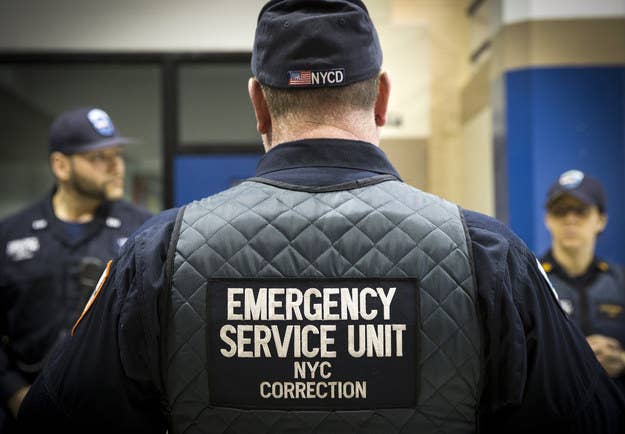
New York City spent $1.1 billion on its jails in 2014, according to the official municipal budget. But a new report by the Vera Institute of Justice suggests New Yorkers actually paid a lot more for their local incarceration facilities.
How much more? About $1.3 billion more, bringing the total price of operating New York's jails to $2.4 billion.
The new report, published on Thursday, takes a deep look at the hidden costs of incarceration in 35 local jurisdictions across the United States, including New York. Vera's experts discovered that municipal budgets consistently underestimate the true cost of keeping people incarcerated pending trial — sometimes by as much as 50%.
"Because the costs reported are too often incomplete, policymakers and the public are seldom aware of the full extent of their community's financial commitment to the operations of the local jail," the authors of the report wrote. "It is striking that the national price tag for jails remains unknown and that taxpayers who foot most of the bill remain unaware of what their dollars are buying."
Unlike prisons, which are run by the states or the federal government, jails are controlled by local authorities in towns and cities. Also unlike prisons, which typically house convicts serving sentences, most inmates in jails have not been found guilty of any crimes and are being incarcerated pending their trial. Although prisons tend to get a lot more attention from advocates from criminal justice reform, many more people pass through jails than through state or federal detention facilities. On any given year, America's jails register some 12 million admissions.
Most of the hidden costs of jail do show up in municipal budgets, but not under rubrics explicitly associated with incarceration. In New York City, for example, the extra $1.3 billion was spent by agencies other than the Department of Correction. The hidden costs of New York's jails included benefits for jail employees, medical care for inmates, and administrative services, according to the Vera report.
Asked about the findings of the report, the office of New York Mayor Bill de Blasio reiterated its commitment to reducing the city's jail population.
"This administration is deeply committed to safely reducing the city's jail population — a strategy that is first and foremost about keeping New York City the safest big city in the country," Monica Klein, a mayoral spokesperson, told BuzzFeed News. "Our critical reforms will help ensure that we are using confinement and law enforcement resources on the greatest public safety threats — and diverting people who could be better served by programs and services within the community."
In order to find out the true cost of jails, Vera's experts enlisted the help of jail financial officers in six different jurisdictions. Together, Vera and the financial officers devised a survey to measure the true cost of jails. They then sent the survey to 250 towns, cities, and other local jurisdictions. The 35 jurisdictions that returned the survey accounted for about 9% of the country's total jail population, and included both very large and very small facilities.
All 35 jurisdictions that participated in Vera's survey had jail expenses that did not appear in their budgets for incarceration, but the proportion of hidden to official costs varied widely. New York City had the highest discrepancy, with an actual jail cost that was 53.6% higher than what it detailed in its budget. Cherokee County, in Georgia, had the most accurate budget, with only 0.1% of its jail costs falling outside its official expenses.
In most jurisdictions, paying employees accounted for the lion's share of the cost of jails. Vera's survey found that 74.2% of the total reported costs — both official and hidden — went to salaries and benefits.
The number of jail employees in the United States has grown dramatically in the past few decades. Between 1983 and 2011, the average proportion of jail employees to inmates remained virtually unchanged at one to three, even as the number of people in jail increased from 223,550 to 735,600. That proportional growth may help explain the explosion in the cost of jails nationwide, which skyrocketed from $5.7 billion to $22.2 billion over the same period.
Those numbers, however, are likely to be underestimates, as they only include jail costs reported in official municipal budgets. In New York City, for example, the Department of Correction paid for the salaries of jail employees, but many of their their benefits were covered by other agencies. These benefits amounted to 70% of the total cost of salaries, according to the Vera report.
New York's jail employees have come under fire several times in the last few years, most recently after a report by New York's Department of Investigation found that up to one third of them shouldn't have been hired in the first place for reasons that ranged from known gang affiliations to extensive criminal records.
Norman Seabrook, the president Correction Officers' Benevolent Association, the union that represents New York City's jail employees, did not respond to a BuzzFeed News request for comment.
Other, smaller portions of the total cost of jails went to paying for inmate health care and for building and repairing facilities, as well as to administrative services, the Vera report found.
By reducing the number of people in jail, the authors of the report wrote, municipal governments can save significant amounts of money, which they can then spend on services that can prevent people from committing crimes in the first place.
"Counties and cities are well-positioned to reinvest jail savings into programs and services that will help keep many people, especially those who are poor or have serious mental illness, from entering or staying in jail in the first place," wrote Nicholas Turner, Vera's president. "And, in terms of public safety, this is a much better investment."
